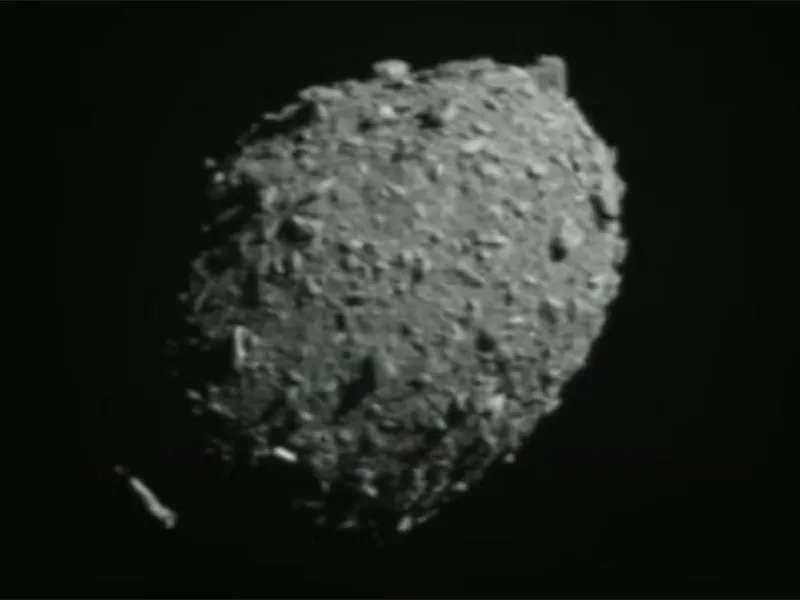- NASA's DART mission successfully impacted the asteroid moon Dimorphos in 2022. The collision altered the asteroid's orbit.
- Now, new research suggests that Dimorphos likely formed from material separated from its larger binary companion, Didymos.
- Future missions to Dimorphos and DidymosLike ESA's Hera mission, it will further explore this binary asteroid system.
A closer look at the impact of DART
In 2022, NASA DART (Double Asteroid Redirection Test) Spacecraft intentionally Crashed with the asteroid moon DimorphicNASA wanted to see how much the impact would alter Dimorphos' orbit, as a test of our human ability to deflect a potential asteroid into a collision course with the Earth. Initial analysis It proved that DART managed to change the asteroid's trajectory. So it was a successful test! But now there's more. On July 30, 2024, NASA scientists saying They have learned more about why DART was so effective. The knowledge relates to the origins of Dimorphos and its larger companion asteroid, Didymos.
The researchers published their peer reviewed findings in five new articles in Nature Communications(See list at the end of this post.)
DART and the origins of Dimorphos and Didymos
DART not only impacted Dimorphos, but studied the geology of both asteroids to learn more about their origins and evolution. The two asteroids orbit each other as a binary pair, although Dimorphos can also be thought of as a smaller “moon” of Didymos. Didymos is about 760 meters (2,500 feet) in diameter, while Dimorphos is about 160 meters (520 feet) long. Thomas Statler is the senior scientist for Small Solar System Bodies at NASA Headquarters in Washington. saying:
These findings give us new insights into the ways asteroids can change over time. This is important not only for understanding the Near Earth Objects which are the focus of planetary defense, but also for our ability to read the history of our solar system from these remnants of planet formation. This is just part of the wealth of new knowledge we have gained from DART.
In one of the new articles, Olivier Barnouin and Ronald Ballouz Researchers at the Johns Hopkins Applied Physics Laboratory (APL) in Laurel, Maryland, examined images of both asteroids to study their geology. The images came from both DART and NASA. LYCIATIC CUBE accompanying Cubesat. The images showed rocks of various sizes on Dimorphos, a smaller asteroid. However, Didymos was different. The larger asteroid was rocky at higher elevations, but smoother at lower elevations. It also had more craters than Dimorphos.

Did Dimorphos split from Didymos?
The findings suggested that Dimorphos likely “broke off” Didymos. That is, material broke off from Didymos’ surface to form Dimorphos. This may have occurred due to Didymos’ accelerated spin.
Researchers found that both asteroids have weak surfaces. The finding also suggests that both asteroids differ significantly in age. Didymos is estimated to be 12.5 million years old. On the other hand, Dimorphos is less than 300,000 years old.
Dimorphs formed in stages
Another article, directed by Mauricio Pajola Researchers from the National Institute for Astrophysics (INAF) in Rome compared the shapes and sizes of rocks and their distribution patterns on the surfaces of both asteroids. The analysis showed that Dimorphos likely formed in stages, from leftover material from Didymos.
In addition, the study yields results of Alicia Lucchettialso from INAF, suggested that Dimorphos experienced thermal fatigueThat process – the gradual weakening of material by temperature fluctuations – could have broken down the rocks on Dimorphos’ surface fairly quickly. This, in turn, would also alter the asteroid’s overall appearance more quickly than previously thought.
As noted above, the results of the DART mission indicate that the surfaces of both asteroids are faint. In fact, in the case of Didymos, the Loading capacity of its surface is at least 1,000 times smaller than dry sand on Earth or the regolith “soil” of the Moon. That study was led by Juana Bigot and Paulina Lombardo at ISAE-SUPAERO in Toulouse, France. The bearing capacity is the ability of the ground surface to support loads applied to the soil, measured as the average contact pressure.
Finally, Robin Tails Researchers at ISAE-SUPAERO in France compared rocks on Dimorphos’ surface to those on asteroids Itokawa, Ryugu, and Bennu. These are what scientists call rubble-pile asteroids, where chunks of rock and debris are loosely held together by gravity rather than a single, more solid mass. Notably, rocks on Dimorphos were found to be quite similar, suggesting that Dimorphos likely formed in a similar way to other rubble-pile asteroids.
Why was the DART mission so successful?
Researchers said Dimorphos' low surface drag likely contributed to DART's significant effect on its orbit. Simply put, it was easy to move.
Barnouin saying:
The images and data DART collected in the Didymos system provided a unique opportunity to get a close-up geological look at a near-Earth binary asteroid system. From these images alone, we were able to infer a wealth of information about the geophysical properties of Didymos and Dimorphos and expand our understanding of the formation of these two asteroids. We also better understand why DART was so effective at moving Dimorphos.
The European Space Agency (ESA) plans to return to Dimorphos and Didymos with its Hera Mission. Its launch is scheduled for October 2024 and its arrival at the asteroids in October 2026.
Bottom line: Scientists analyzing data from the DART mission in 2022 found new evidence of how the binary asteroid system Didymos and Dimorphos originated.
Sources:
The carrying capacity of asteroid (65803) Didymos is estimated from rock footprints
The geology and evolution of the near-Earth binary asteroid system (65803) Didymos
Rapid fracture of rocks due to thermal fatigue detected in rocky asteroids
Read more: How DART deflected an asteroid (but released a swarm of rocks)
Read more: Photos of the “after” of DART's collision with an asteroid